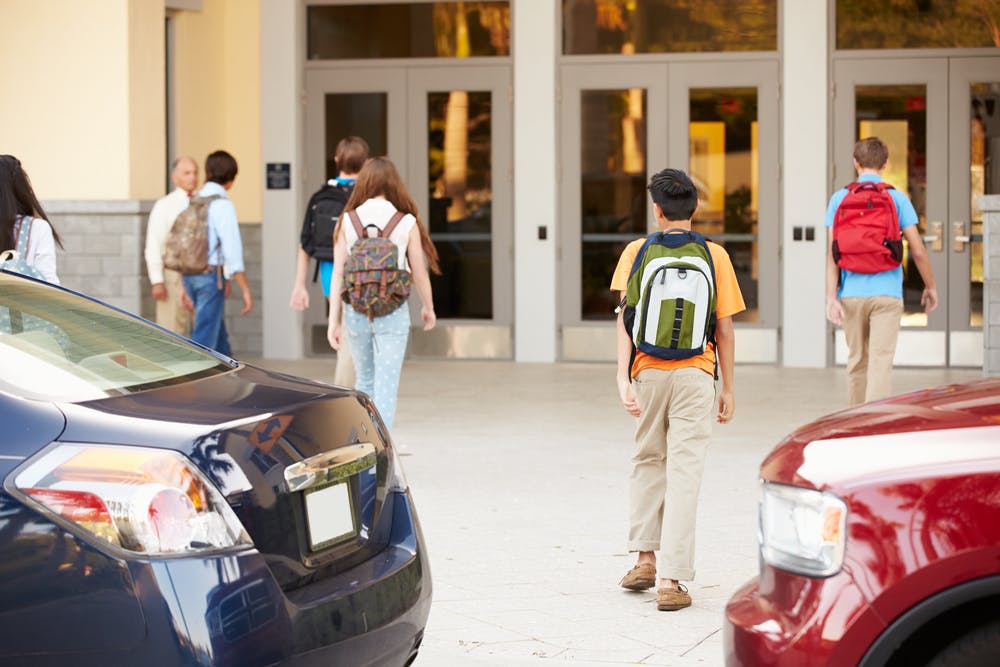
Many schools are closing roads and setting up park and stride schemes in an effort to reduce air pollution and improve the physical and mental wellbeing of students
Schools across England and Scotland are looking to address the morning school run amidst concerns over the impact of air pollution on young people’s health according to The Guardian. Aiming to discourage parents from using their cars to pick up and drop off primary and secondary school aged children, schools have introduced a number of schemes including walk to school initiatives, closing roads in the immediate area, and setting up “park and stride” schemes to keep heavy pollution away from the school gates.
In London, Hackney council have closed roads outside of five schools in a bid to reduce pollution, with plans to extend the scheme to another 12 locations. Westminster is due to launch a similar scheme from September this year.
Nine Edinburgh schools have successfully banned parents from dropping children off at school, with plans to roll out the scheme to other schools across the city.
One school in Stockport has even introduced a park and stride scheme to discourage parents from driving to the school gates.
Recent reports have highlighted the damaging impact air pollution can have on both children and adults, prompting many to take action and find new ways to combat the problem. A recent report linked air pollution with spikes in hospital and GP visits. A 2017 joint investigation between Greenpeace and the Guardian found more than 2,000 schools and nurseries located close to roads could have damaging levels of diesel fumes, potentially exposing hundreds of thousands of children to illegal levels of air pollution.
UK Charity Living Streets works with more than 2,000 schools to promote the impact on air pollution, as well as physical and mental health benefits of walking to school can have.
Where 70% of children walked to school just one generation ago, now less than half do. Promoting challenges and schemes to get primary and secondary school aged children walking to school one day a week or more, Living Streets promote three key benefits to walking to school:
- Happier children – by getting exercise before school through walking, children arrive refreshed and ready to learn.
- Less congestion – an estimated one in five cars on the road during morning rush hour is taking children to school, contributing to busier roads and more air pollution. By switching to walking, this can help reduce heavy traffic around schools and combat driving related stress.
- Cleaner air – according to Living Streets, over two million tonnes of CO2 is created each year from the school run alone. Through ditching the car on one day or more we can help decrease this and work towards cleaner air around schools.
With two in five primary school parents worried about pollution levels around their children’s schools, in 2017 alone, Living Streets helped encourage over 600,000 students across 2,200 schools walk to school in a bid to get active, improve air quality, and practice road safety.
Living Street’s School Run Report highlighted additional physical and mental health benefits walking to school can have for children and teens. With 80% of boys and 72% of girls aged five to 15 failing to meet government physical activity guidelines, as many as one in three children are leaving primary school overweight or obese. A further 15% of children demonstrate symptoms of mental ill-health, the report states.
By encouraging and enabling children to walk to school, schools can support children’s mental and physical wellbeing. Supporting children and parents to walk to school over driving can also help build healthy exercise patterns, increasing the likelihood for children to continue being physically active as adolescents and adults.
The charity highlights positive impacts walking regularly can have on children. Over 50% of parents interviewed in their report said their child’s mood always or sometimes improved after walking to school.
Walking regularly can be a positive form of self-care, providing time to reflect on the way to picking kids up or on the way back from dropping them of. It can also create an opportunity for quality time to talk with children without the stress of rush-hour traffic and driving.
Whilst plans proposed by schools seem to have been successful as a whole so far, many schemes do raise questions around their feasibility for working parents who drop children off on the way to work; families with mobility issues; and those who live outside of walking distance from their school.

